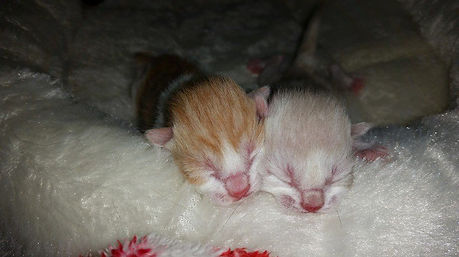I FOUND A KITTEN WHAT DO I DO!
So, you found a stray kitten … but the next step isn’t simply taking him home with you. What do you feed a stray kitten? Where should you take stray kittens if you can’t care for them yourself? And how do you determine if the kitties are in fact strays in the first place?

Investigate — does the stray kitten have a mother?
Helping orphaned kittens will first require some detective work. One of the biggest mistakes people make when finding stray kittens is taking them away from their mother. Neonatal kittens are still nursing and need to be fed frequently, so they should be kept with their mother, if possible, Mother Cat is always the best option
Here’s how to assess the situation:
-
Are the kittens sleeping comfortably? The mother is probably coming back.
-
Watch from at least 35 feet away or more and may need to leave completely. Mother may not return if she senses you are to close, she may take several hours to return.
-
If you need to leave before Mother cat comes back evaluate whether the kittens are in immediate danger (weather, animals (wild or domestic), kids or adults who may harm them, foot or car traffic). To help in yours decision, it is important to know that it may take several hours form mother cat to return and healthy kittens can survive this period without food as long as they are warm. Neonatal kittens are much more at risk of hypothermia then they are starvation. During spring and summer months, waiting longer to see if mom comes back is much safer than during winter months.
-
To be absolutely sure, you can sprinkle some flour around where the kittens are located and look for paw prints upon your return. If the mother is in the picture, let them be. In approximately eight weeks, go back and TNR the whole family.
If mom returns the area is relatively save, and you should leave the kittens alone with mom until they are weaned. you can offer a shelter and regular food to mom, but keep the food and shelter at a distance for each other to keep from attracting other animals to the nest.
What to do if mother cat does not return:
If you discover that mom has been hit by a car, or if for any reason it appears that she is not coming back, then you should remove the kittens. This is crucial to the kittens’ survival. But you must be prepared to see this project through to weaning if you decide to intervene!
If you take the kittens in, it is unlikely that you will find an organization with available staff or volunteers to take on bottle-feeding on short notice. Some organizations do have experienced bottle-feeders, but prior logistical planning is necessary. Animal shelters and veterinarians generally do not take in newborn kittens, since they do not have the staff to feed and stimulate them for elimination around-the-clock.
First Steps:
-
Prepare for bottle-feeding and proper care before you take the kittens off the street.
-
If you feel you must take the kittens in, wrap the carrier or container you will transport them in in a towel for warmth, but make sure you leave air holes uncovered so the kittens won’t suffocate.

-
Check to see if the kittens are warm. This is more important than feeding. Never feed a cold kitten! If the kittens are cold, you will need to warm them up slowly. You can tell a kitten is cold if the pads of his feet and/or ears feel cool or cold. Put your finger in the kitten’s mouth. If it feels cold, then the kitten’s temperature is too low. This is life-threatening and must be dealt with immediately. Warm up the kitten slowly over 20 minutes by wrapping him in a towel or baby blanket, holding him close to your body, and continually rubbing him with your warm hands.
-
Determine the age of the kittens by comparing them to the photos and descriptions in the Kitten Care Guide on the How Old Is That Kitten? Kitten Progression: At-a-Glance page on the Alley Cat Allies website.
-
Neonatal kittens (under four weeks of age) cannot eat solid food (not canned, not dry) and cannot urinate or defecate on their own, so you must bottle-feed them around-the-clock and stimulate their genitals after every feeding so they can eliminate. For example, if you have kittens less than one week old, they will need to be fed and stimulated every three hours. That means you will be caring for them eight times a day — for example, at midnight, 3:00 a.m, 6:00 a.m, etc. If the kittens are unusually small or sickly, they might need to be fed every two hours.
-
Skipping feedings or overfeeding can cause diarrhea, which results in dehydration, a condition that can be fatal for small kittens (not to mention a hassle for you to clean up after). Diarrhea requires a visit to the veterinarian.
-
As the kittens age, the number of feedings they need per day goes down. You can start weaning at four weeks of age.
-
You should only feed kittens a milk replacement formula such as KMR (NEVER FEED COWS MILK TO KITTENS)



